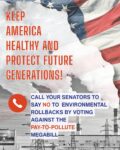- Share on Facebook
- Like
- Digg
- Tumblr
- VKontakte
- Buffer
- Love This
- Odnoklassniki
- Meneame
- Blogger
- Amazon
- Yahoo Mail
- Gmail
- AOL
- Newsvine
- HackerNews
- Evernote
- MySpace
- Mail.ru
- Viadeo
- Line
- Comments
- SMS
- Viber
- Telegram
- Subscribe
- Skype
- Facebook Messenger
- Kakao
- LiveJournal
- Yammer
- Edgar
- Fintel
- Mix
- Instapaper
- Copy Link
- Bluesky
by Vickie Wolfe
Here’s a little quiz for you: Rank the following actions in order from GREATEST to SMALLEST positive impact on the environment:
(a) Becoming a vegetarian
(b) Recycling
(c) Having fewer children
(d) Driving a more fuel-efficient vehicle
A similar question to this one appears on the quiz I give my introductory biology students on the first day of class. If (b) is at the top of your list, the good news is that you have a lot of company: recycling is one of the answers chosen most often by my students as well. The correct ranking is c, d, a, b.
Over the coming weeks and months, we’ll explore a number of misconceptions about the environment. Today we’ll start with the misconception that “China, India and Indonesia are the countries that have a problem with overpopulation; the United States does not.”
In a recent 20/20 broadcast, John Stossel argued that overpopulation is a myth. He used the common argument that the Earth isn’t overpopulated because we still have plenty of space. There are, however, many other resources that will become scarce before space does—resources like energy, water, land to grow food.
R. S. McNamara developed the following equation to illustrate the relationship between population, consumption and environmental damage: Ed = P x C x D, where
Ed = Environmental Damage
P = Population
C = Consumption per person
D = Environmental damage per unit of consumption
We can therefore reduce Environmental Damage (Ed) by reducing either P, C or D. Now, to get back to our misconception concerning which countries have the worst “population problem” . . . well, that would be the countries in which each additional person has the greatest negative impact on the environment—the countries in which consumption is greatest. You guessed it—the U.S. is at the top of the list.
Someone has estimated that, if everyone on Earth consumed the planet’s resources at the rate the average American does, we would need four additional planets! (You can calculate your own “ecological footprint” in less that five minutes here) So not only do we need to slow our rate of reproduction, we need to reduce “C” (consumption) and “D” (environmental damage per unit of consumption) as well. Following are some examples of ways to do so; I’m sure you can think of others.
- Drive a more economical vehicle; don’t forget that was second on the list!
- Eat a diet that is more plant based, less animal based; more on this in future columns.
- Produce that is grown locally and organically has a much lower environmental impact than that which is grown non-organically and/or shipped long distances.
- Buy shade-grown coffee. It is produced with less pesticides and the shade trees provide habitat for birds.
- Decline paper and plastic shopping bags; take your own fabric bags when you go shopping.
- Use compact fluorescent light bulbs.
- Buy Energy Star appliances.
- Buy products made from recycled raw materials, e.g. recycled paper.
- Use BOTH sides of paper.
Dr. Wolfe teaches biology at Marshall University. She holds graduate degrees in Environmental Health and Environmental Science and writes for the WV Environmental Council www.wvecouncil.org
Again, the “fine print”….
Permission for use is granted only when the column is used
in its complete and unabridged, unedited form. Any changes void permission to use.







